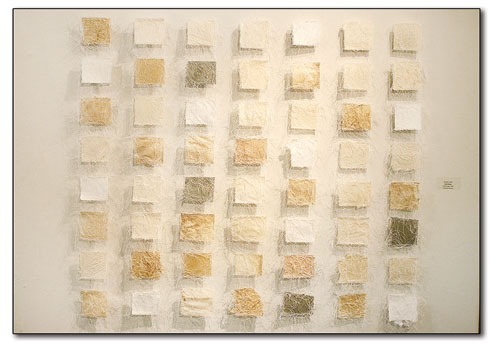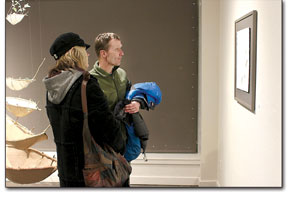
Andrea Marten’s "So Hum (I:That)" a thread sculpture on handmade paper, is one of several pieces on display at the Durango Arts Center’s “The White Season” exhibit. The show, which runs through January, features seven local artists, who incidentally are all female./Photo by Jennaye Derge
White on white
DAC exhibit celebrates ephemeral beauty of winter
by Stew Mosberg
Call it divine intervention, but the recent snows could have been a portent of the latest show to hit the Durango Arts Center.
Just the FactsWhat: “The White Season,” a seven-woman mixed-media show Where: Durango Arts Center, 802 E. 2nd Ave. When: Through Sat., Jan. 30, 10 a.m. - 5 p.m. |
“The White Season,” as it is titled, was conceived as a celebration of winter’s offering and is dedicated to Durango’s late artist, educator and environmentalist, Karen Pittman. As described in the DAC’s invitation, “White Season” is the “interpretation of how winter recollections for many of us embrace serenity, silence, grace, tranquility and eternity.”
The seven women artists represented in the exhibition — Sandra Butler, Charlene Geiss, Andrea Martens, Maureen May, Catherine Nash, Joan K. Russell and Mary Ellen Long – have all successfully achieved the objective.
The work includes a broad range of mediums including sculpture, collage and installation, with nary a painting of snow-capped mountains or frozen streams in sight.
DAC Exhibits Director Mary Puller had the original vision for a winter show that was quiet and meditative and invited Nash and Long to put together a show that would be representative of the theme. Long approached Butler and Russell and now admits thinking they would work on a collaborative installation. When she found that they wanted to work separately, she invited others to join in with their own projects that echoed the theme. You could say the project snowballed from there. “And that,” she says, “is how the show came together.”
Like many Durango residents, Long embraces winter’s serenity. “The white season (is) one of my favorite times of the year; a time to retreat into my studio and produce,” said the well-regarded environmental artist.
As she thought about the theme of the show, she says she found inspirational poetry and metaphoric ideas that led her to use ice, mica, white and silver paper, silk, and paint to express her emotions. Long has numerous pieces in the show, most all of them using her signature hand-made papers. One is a collaborative installation with Tucson artist Nash which incorporates paper-covered branches and pages from books that have been buried. Another of Long’s impressive pieces features floor-to-ceiling silk panels strung with slivers of mica that catch light and movement. She has many others that are equally creative, and visitors can spend a great deal of time considering their skill and originality.
Geiss is best known as a mixed-media diarist, but the work she is showing represents what she refers to as, “A sacred and psychological exploration of my inner world.” Accustomed to expressing herself through remarkably beautiful journals, with this exhibit, Geiss says she set out to “share the voice of her soul.”
 |
|
Gallerygoers Shaun and Lisa Smith take in “Om,” by Charlene Geiss, during the opening of “The White Season” at the DAC on Jan. 8./ Photo by Jennaye Derge |
She also uses hand-made paper, but in this instance rather than taking pen or brush to the surface she has punctured it with intricate designs, often with sacred mandala motifs. Thousands of tiny pin holes evoke the spiritual sand paintings of monks, but in this case are devoid of color. The effect is as pure as the driven snow and equally stunning in its simplicity.
Martens explained said it was an honor to be invited to show alongside her fellow artists and celebrate the season. “For many of us here in Durango, winter has a special place in our hearts,” she said. With some half dozen works in varying sizes, Martens’ pieces also incorporate crafted paper and mixed media. Handmade paper, inherently strong, luminous and resilient, lends itself to the task at hand, she says. “I hope my work in the show reflects the winter season, which is rich with light, stark shadows and stillness.” One particularly interesting panel of hers includes small tears in the paper, picked away from the surface, creating a texture reminiscent of a wind-swept, snow-covered field.
Catherne Nash has fashioned an intriguing mobile of pod-like “nesting boats” using tissue-thin Japanese Kozo paper made from vegetable fiber.
May, one of the most versatile artists in Durango, is represented by a number of small photo-based, abstract images of ice crystals and frost in starkly beautiful winter colors. Appropriately called the “Ice Box” series, they are accompanied by haiku style poems which set the mood as much as the visual elements. One poem, “As if a horde of moon lit moths sought refuge from the squall,” is in itself as sparse, terse and provocative as the art she created.
Butler, who is also the DAC education director, can always be counted on to produce unusual art – and this show is no exception. With just two hanging pieces in the gallery, Butler has encapsulated the winter theme through the use of painted netting constructed into massive icicles. They started with fishing net to provide a form that was both light and see-through, she said of the construction process. After the forms were sewn, she used sand and a multitude of paint mediums to create a varying of thicknesses, colors, textures and surfaces. She also beaded a long strand of crystals to hang on the inside and spin – which led to a sweet serendipity. “The movement and sparkles allows the shadows of the pieces to look like it is snowing on the wall,” she said. “This was a wonderful surprise to me.”
Rounding out “White Season” are four paintings by Russell, which are presented as two diptychs: “Winter Suite 1” and “Winter Suite 2,” which and meant to create a point-counterpoint perspective. The work, says Russell, “Symbolizes the darkness of winter and death and the complex network of our spiritual connection to each other.” She also explores the loss of depth perception when the snow is falling and, what she explains as the” de-materializing of our physical self.”
With the second diptych, Russell portrays a blue sky with hawks soaring in a circle, symbolizing departure from the earth and the dematerializing nature of things and their delicate fragility.
For a departure, but equally intriguing visual journey, head upstairs to the art library where you will find “Irregularities,” a captivating exhibit of unique work by Durango artist Jen Pack. Having invented and perfected a technique of her own design for this exhibit, Pack has created lineal and geometric compositions juxtaposing colorful ribbon or thread. The intriguing two- and three-dimensional pieces are fashioned on framework structures built by the artist. The limited library space provides only a small representation of her range and talent.
In this week's issue...
- January 25, 2024
- Bagging it
State plastic bag ban is in full effect, but enforcement varies
- January 26, 2024
- Paper chase
The Sneer is back – and no we’re not talking about Billy Idol’s comeback tour.
- January 11, 2024
- High and dry
New state climate report projects continued warming, declining streamflows
